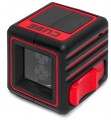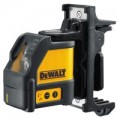Measurement range
The range at which the device remains fully operational without the use of additional receivers (see below); in other words, the radius of its action without auxiliary devices.
In some models, a range may be specified that shows the minimum (
3 cm,
5 cm) and maximum measurement ranges. But in most cases, only the maximum value is indicated.
The specific meaning of this parameter is determined by the type of instrument (see above). So, for optical levels, the measurement range is the greatest distance at which the operator can normally see the divisions of a standard leveling staff. For laser levels, this parameter determines the distance from the device to the surface on which the mark is projected, at which this projection will be easily visible to the naked eye; and in rangefinders we are talking about the greatest distance that can be measured. Typically, the measurement range is indicated for ideal conditions - in particular, in the absence of impurities in the air; in practice, it may be less due to dust, fog, or vice versa, bright sunlight "overlapping" the mark. At the same time, tools of the same type can be compared according to this characteristic.
Note that it is worth choosing a device according to the range of action, taking into account the features of the tasks that are planned to be solved with its help: after all, a large measurement range usually significa
...ntly affects the dimensions, weight, power consumption and price, but it is far from always required. For example, it hardly makes sense to look for a powerful laser level at 30-40 m if you need a device for finishing work in standard apartments.Measurement range (with receiver)
The longest measurement range provided by a laser level (see “Type”) when using a special receiver with a photocell.
Thanks to its sensitivity, such a receiver is able to respond even to a weak laser beam, the mark from which is no longer visible to the naked eye; At the same time, the area of the photocell is quite large, and special indicators make it possible to determine the exact position of the mark. Among other things, this significantly expands the range of action of the level - the measurement range with a receiver is usually several times greater than without it. On the other hand, such equipment inevitably affects the overall cost of the device; and in some models the receiver
is not included in the package at all; it must be purchased separately. However, the second option also has its advantages: you do not need to immediately pay for an additional accessory, it can be purchased later, when a real need arises, while some models allow you to choose the optimal receiver model from several options at your discretion.
Note that the receiver can be useful not only for increasing range; These points are described in detail in paragraph “Included parts”.
Accuracy
Accuracy is described as the maximum deviation from the true value of the measured parameter, which the device can give if all the rules for its operation and the corresponding measurements are observed. In both rangefinders and levels, this parameter is usually designated for a certain distance — for example, 3 mm at 30 m; but even for one manufacturer, these "control" distances may be different. Therefore, in our catalog, the accuracy of all devices is recalculated for 1 m distance; with such a record, for the example above, it will be 3/30 \u003d 0.1 mm / m. This makes it easier to compare different models with each other.
It is also worth mentioning that the meaning of the "accuracy" parameter for different types of measuring instruments (see "Type") will be different. For optical levels, it is described in the "SKP" paragraph above. For laser levels of all types, accuracy is the maximum deviation of the mark from the true horizontal (or vertical, if such a function is provided), and for the horizontal, we can talk about both moving the mark up / down and turning it. In rangefinders, this characteristic describes the maximum difference (both in "plus" and "minus") between the readings of the device and the actual distance to the object.
Anyway, the smaller the error, the better; on the other hand, accuracy significantly affects the price of the device. Therefore, it is necessary to choose a specific model for this parameter, taking into account the...specifics of the planned work. For example, for a relatively simple repair in a residential apartment, a high-precision tool is unlikely to be required; and recommendations for more complex tasks can be found in specialized sources, ranging from expert advice to official instructions.
Self-leveling angle
The maximum deviation from the horizontal position that the device is able to correct "by its own means".
Self-leveling in itself greatly simplifies the installation and initial calibration of levels (see "Type"), which often (and for optical models — mandatory) need to be set horizontally to work. With this function, it is enough to install the device more or less evenly (in many models, special devices are provided for this, such as round levels) — and fine tuning in the longitudinal and transverse planes will be carried out automatically. And the limits of self-leveling are usually indicated for both planes; the higher this indicator, the easier the device is to install, the less demanding it is to the initial placement. In some models, this figure can reach 6 – 8 °.
Diode emission
The wavelength of the radiation emitted by the LED of the level or rangefinder; this parameter determines primarily the colour of the laser beam. The most widespread in modern models are LEDs with a wavelength of about 635 nm — at a relatively low cost, they provide bright red radiation, giving a well-visible projection. There are also green lasers, usually at 532 nm — the marks from them are even better visible, but such LEDs are quite expensive and rarely used. And radiation with a wave longer than 780 nm belongs to the infrared spectrum. Such a laser is invisible to the naked eye and is poorly suited for leveling, but it can be used in rangefinders — of course, with a viewfinder (see "Type" for more details).
Beam angle (vertical)
The sweep angle in the vertical plane provided by the level emitter. If there are several such radiators (for example, on both sides of the case), this parameter is given for each of them separately.
The sweep angle is, in fact, the coverage angle, that is, the width of the sector captured by the emitter when the line is formed. The wider this angle, the more convenient the device is to use, the lower the likelihood that the device will have to be moved up and down to build a line. On the other hand, a larger sweep angle (at the same range) requires more power — and this, accordingly, affects the cost and power consumption.
Beam angle (horizontal)
The sweep angle in the horizontal plane provided by the level emitter. If there are several emitters, their total coverage angle is indicated here; a typical example of such devices are models for full 360 °, not related to rotation.
Actually, all rotary devices, by definition, provide a coverage of 360 °. Therefore, it is worth paying attention to this parameter in cases where we are talking about more traditional laser levels. And here it is worth considering that a larger coverage angle, on the one hand, can provide additional convenience, on the other hand, it increases the price and power consumption of the device. So when choosing, you should proceed from real needs; detailed recommendations on this subject can be found in special sources.
Compensator locking
Ability to disable the compensator installed in the level. To be more precise, we are talking about the ability to disable the self-leveling system (recall, it is used to automatically bring the device to the horizontal during initial installation).
Blocking the compensator can be useful in two cases. The first is transportation: compensators are rather delicate mechanisms, and when switched on, they do not withstand the shocks and shocks that the device can be subjected to when moving from place to place. The second case is the installation of the device at an angle, when bringing it to the horizontal is simply superfluous.
Power source
The type and number of batteries used in the level/distance meter. All elements of standard sizes (
AA,
AAA,
C,
D,
PP3) are available in two formats — disposable batteries and rechargeable batteries. This gives the user a choice: either buy relatively inexpensive batteries every time, or invest once in a rechargeable battery with a charger, and then simply charge the battery as needed.
Branded batteries are, by definition, made only rechargeable, as are
18650 batteries.
Specific types of power today can be as follows:
— AA. A standard battery, known as a "finger battery". The power of these batteries is average, they can be used both in simple and quite advanced devices. This power supply is convenient due to the fact that AA batteries are very widespread and sold almost everywhere — due to this, finding and replacing them is usually not a problem.
— AAA. A smaller version of the AA element described above — almost identical in shape, but thinner and shorter. Such elements, known as "mini-finger" or "little fingers", have a rather low capacity and power, but are useful for portable devices, where compactness is crucial. They are also quite widespread.
— C. A cylindrical element, in the form of a rather thick "bar
...rel" — with a length of 50 mm, the diameter is 26 mm. Due to its higher capacity and power than AA, it is better suited for advanced models with "long-range" lasers, but is less commonly used and generally less common.
— D. The largest and most capacious type of standard batteries found in modern levels and distance meter: thickness and diameter are 62 and 34 mm, respectively. The main area of application for D batteries is powerful professional devices.
— Rechargeable battery. In this case, the tool is powered by an branded battery that does not belong to any standard size. This option is good because such batteries are initially created for a specific model of the level/distance meter and are supplied in the set (and in some models they are made non-removable); in addition, their specifications can significantly exceed those of standard elements of a similar size and weight. On the other hand, such power source is less convenient when the charge runs out at the wrong moment: the only way to remedy the situation is usually to recharge, and it takes quite a long time (whereas standard batteries can be replaced in just a minute).
– 18650. The name of these batteries comes from their dimensions: 18.6x65.2 mm, cylindrical, outwardly they resemble somewhat enlarged AA batteries, but they have an operating voltage of about 3.7 V and a higher capacity. In addition, all 18650 type batteries are by definition not disposable, but rechargeable batteries (lithium-ion type).
— PP3. 9-volt batteries of a spesific rectangular shape, with a pair of contacts on one of the ends. Due to the high operating voltage, they provide high power and actual capacity, so one such battery is usually enough for operation.
— LR44. Miniature batteries of "coin" type, 11.6 mm in diameter and 5.4 mm thick. Usually installed in sets of 3 and are used in compact low-power laser levels, for which small size is more important than power and capacity. Note that specifically the LR44 marking refers to relatively inexpensive alkaline batteries; more expensive and advanced silver-zinc power supplies are referred to as SR44, or 357.
— 23A12V. A rather rare option: cylindrical batteries (length 29 mm, diameter 10 mm) with a nominal voltage of 12 V.
